Joan Miro (1893-1983)
Get a Miro Certificate of Authenticity for your painting (COA) for your Miro drawing.
For all your Miro artworks you need a Certificate of Authenticity (COA) in order to sell, to insure or to donate for a tax deduction.
Getting a Miro Certificate of Authenticity (COA) is easy. Just send us photos and dimensions and tell us what you know about the origin or history of your Miro painting or drawing.
If you want to sell your Miro painting or drawing use our selling services. We offer Miro selling help, selling advice, private treaty sales and full brokerage.
We have been authenticating Miro and issuing certificates of authenticity since 2002. We are recognized Miro experts and Miro certified appraisers. We issue COAs and appraisals for all Miro artworks.
Our Miro paintings and drawings authentications are accepted and respected worldwide.
Each COA is backed by in-depth research and analysis authentication reports.
The Miro certificates of authenticity we issue are based on solid, reliable and fully referenced art investigations, authentication research, analytical work and forensic studies.
We are available to examine your Miro painting or drawing anywhere in the world.
You will generally receive your certificates of authenticity and authentication report within two weeks. Some complicated cases with difficult to research Miro paintings or drawings take longer.
Our clients include Miro collectors, investors, tax authorities, insurance adjusters, appraisers, valuers, auctioneers, Federal agencies and many law firms.
We perform Joan Miro art authentication, appraisal, certificates of authenticity (COA), analysis, research, scientific tests, full art authentications. We will help you sell your Joan Miro or we will sell it for you.
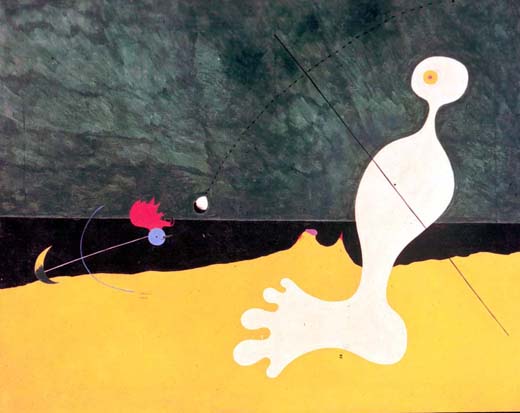

Miro was one of the key Surrealists of the twentieth century. Younger than Duchamp, Ernst, Picabia, or Picasso, he learned about the avant-garde of Paris second-hand by seeing reproductions of their work at galleries in his native Barcelona (Arnson, History of Modern Art, p. 350).
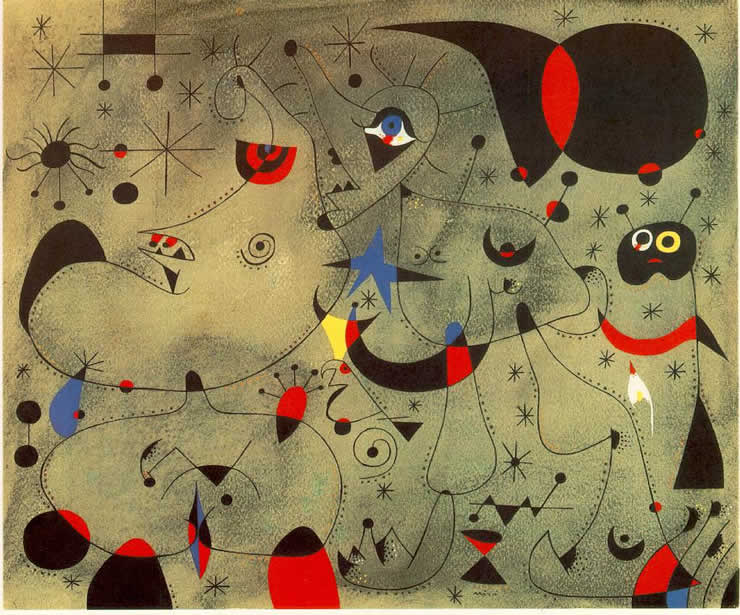
He spent most of his life in the Catalonia part of Spain, in Barcelona and Mallorca and considered himself a Catalan rather than a Spaniard. As a result, a substantial body of writings, archives and reference material is in the Catalan language. The rest is in Spanish and French, because he lived in Paris several years and worked for decades with the fine art printer Mourlot to publish his lithographs. He also worked a little in New York.

In 1919, Miro moved to Paris. While his early work was more influenced by Cubism and even Fauvism, after leaving Spain, his work more clearly shows the influence of the Surrealists. Miro did not have his own studio until late in life, after World War II. While in Paris, friends allowed him to use various studios temporarily. He was impecunious during this Paris period; starved of food and outside sources of entertainment, he was plunged into the world of his own subconscious.

In contrast to this rich inner-world focus, Miro’s work is typically almost minimalist in its use of space. It almost inevitably includes flat biomorphic shapes, moving in a seemingly gravity-less environment. Curved lines appear and guide the viewer through the composition. Miro’s works usually features creatures combining the mystical with the primitive and childlike, as in the painting below.
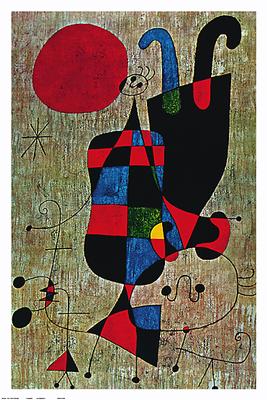
Miro’s works seem to be profoundly symbolic, but the meaning of the symbols isn’t always obvious. They feature identifiable, simply-rendered shapes, such as the moon, birds, and women in the painting above. These are combined in a personal, sometimes arcane, sometimes joyous, language and distinctive iconography. Over the course of his life, one can trace the development of a particular theme: stars, birds, the sea, animals, and indefinable biomorphic forms. In comparison, the subject work is characterized by a more uniform, schematic color field. The shapes in the subject work are simple as well, but less rooted in nature or a personal mythology; they are more purely abstract. The overall design of the subject work is bold, even stark in comparison with the playful, whimsical character of authenticated Miro’s.
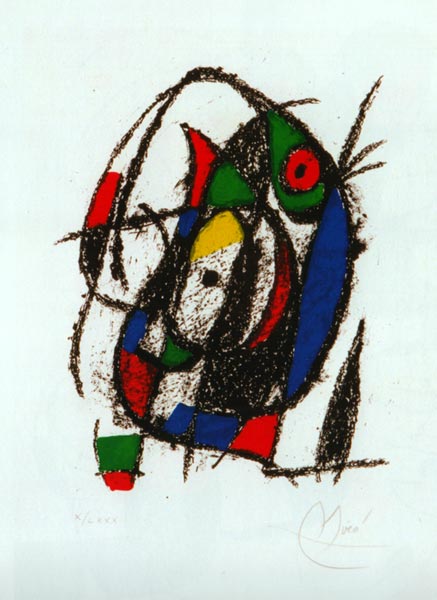
Miro had a penchant for the subversive side of Surrealism. He also liked using offbeat supports for his drawings, for example, newspapers, sandpaper, books and even calendars. In his appropriation and transformation of found objects, he insisted on a connection with reality, even if the level of reality he explored was metaphysical rather than empirical.
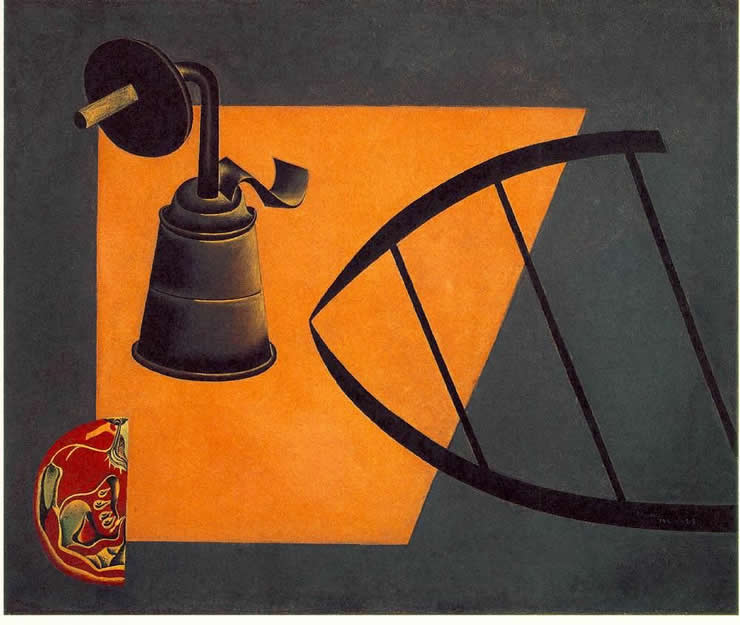
In undisputed Miro drawings of the 1950’s to the end of his life, color is used more sparingly than in the subject work. The palette of the subject work is nearly iridescent. Its colors were not found in a search of all the available literature and online research services for other drawings, paintings, lithographs, or any other authenticated work by Miro. Between his paintings, numerous drawings, ceramics, many series of etchings, woodcuts, engravings and lithographs there are perhaps 150,000 original Miro’s. The Miro Foundation alone has a collection of 11,000 pieces. The result is a vibrant Miro market. Every year some 60 million dollars are spent for his works, sometimes more, if some important Miro collection is dispersed.
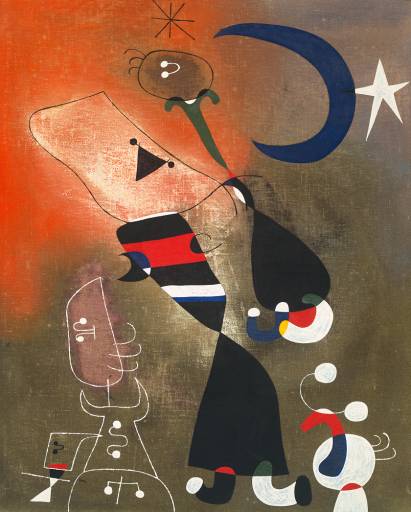
We are periodically asked to research or authenticate Miro works and we are well equipped to do so, being that we are fluent in all the archives and reference material languages, including Catalan. Most of Miro’s works are happy and playful. We enjoy them and always look forward to looking again at what he created. Still wondering about an Abstract or Surrealist painting hanging in your home? Contact us…it could be by Joan Miro!
Reviews
1,217 global ratings
5 Star
4 Star
3 Star
2 Star
1 Star
Your evaluation is very important to us. Thank you.
